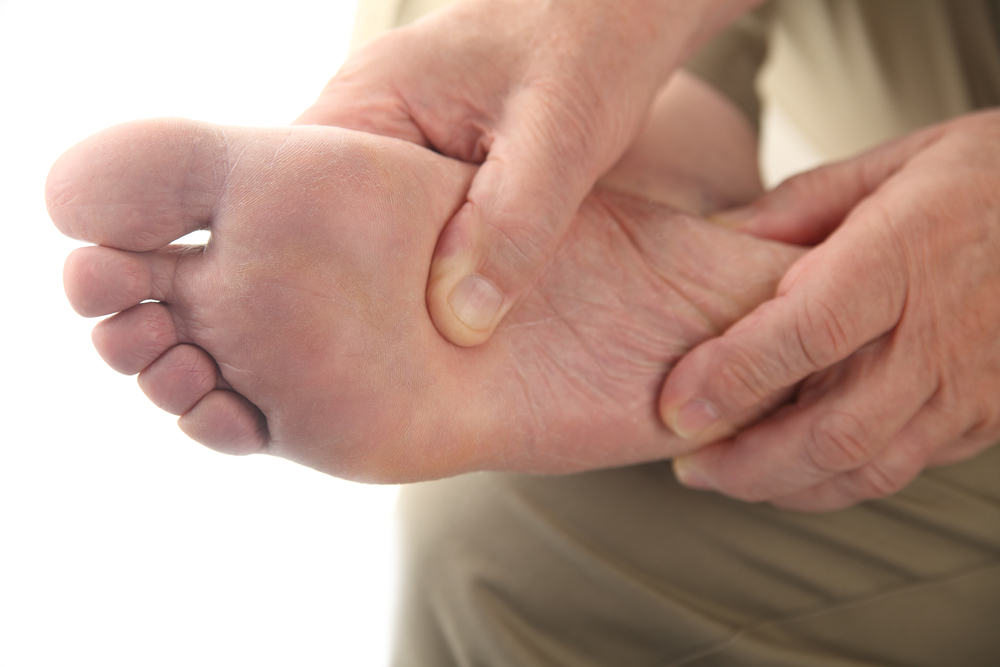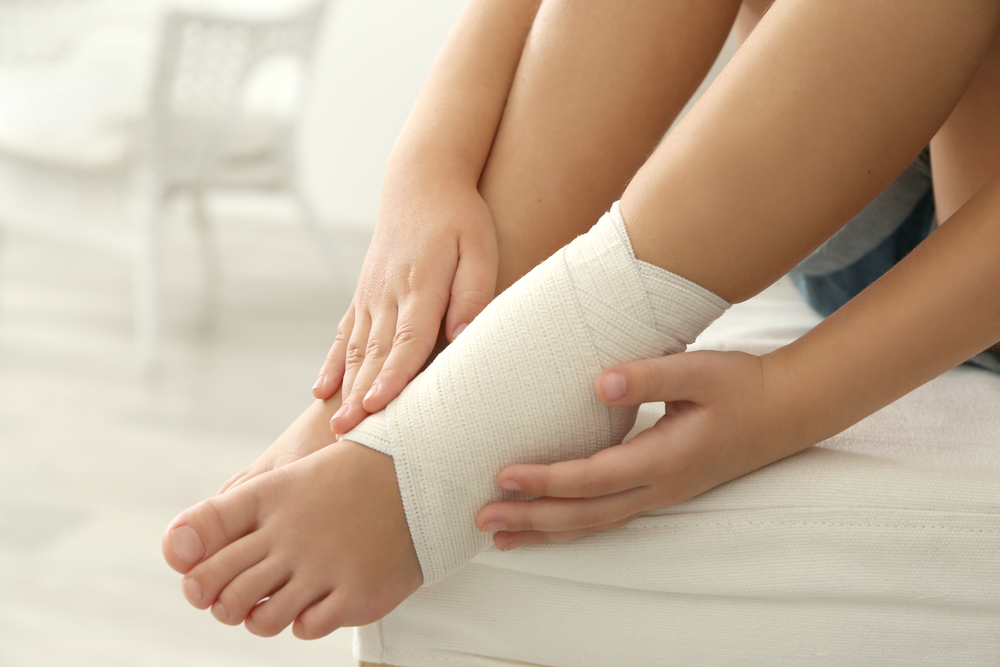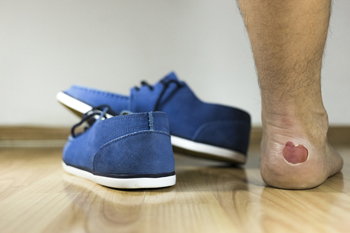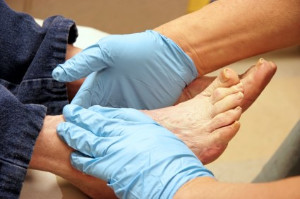July 2020
Signs of Excessively Sweaty Feet
Hyperhidrosis is a medical condition that causes excessive sweating, often in specific areas of the body such as the feet. Excessive sweating typically begins in adolescence and may have genetic causes. It tends to affect both sides of the body equally. Signs and symptoms of hyperhidrosis of the feet include frequent, unexplainable sweating, clammy or wet soles, sweat-soaked socks and shoes, friction blisters, and a strong odor. Hyperhidrosis can also increase the risk of developing fungal infections of the feet and toenails, as fungus thrives in moist environments. If you find that your feet sweat excessively, visit a podiatrist who can help find the right treatment for you.
If you are suffering from hyperhidrosis contact Dr. Thomas Madden of Advanced Foot Care Center. Our doctor can provide the care you need to attend to all of your foot and ankle needs.
Hyperhidrosis of the Feet
Hyperhidrosis is a rare disorder that can cause people to have excessive sweating of their feet. This can usually occur all on its own without rigorous activity involved. People who suffer from hyperhidrosis may also experience sweaty palms.
Although it is said that sweating is a healthy process meant to cool down the body temperature and to maintain a proper internal temperature, hyperhidrosis may prove to be a huge hindrance on a person’s everyday life.
Plantar hyperhidrosis is considered to be the main form of hyperhidrosis. Secondary hyperhidrosis can refer to sweating that occurs in areas other than the feet or hands and armpits. Often this may be a sign of it being related to another medical condition such as menopause, hyperthyroidism and even Parkinson’s disease.
In order to alleviate this condition, it is important to see your doctor so that they may prescribe the necessary medications so that you can begin to live a normal life again. If this is left untreated, it is said that it will persist throughout an individual’s life.
A last resort approach would be surgery, but it is best to speak with your doctor to find out what may be the best treatment for you.
If you have any questions please feel free to contact our office located in Killeen, TX . We offer the newest diagnostic and treatment technologies for all your foot and ankle needs.
How a Podiatrist Can Help with Diabetes
 Podiatrists play an important role in helping people with diabetes maintain healthy feet. A podiatrist can perform vascular testing to determine if you have reduced blood flow to your feet and can diagnose peripheral neuropathy, a common cause of lower limb weakness, numbness, and pain. A common symptom of diabetes are ulcers on the feet. A podiatrist can provide care for ulcers and prevent new ones from developing. As people with diabetes face an increased risk of limb amputation, it is important to see a podiatrist for monitoring, routine care, and prevention. If you have diabetes and experience pain or other symptoms in your legs and feet, don’t hesitate to consult a podiatrist.
Podiatrists play an important role in helping people with diabetes maintain healthy feet. A podiatrist can perform vascular testing to determine if you have reduced blood flow to your feet and can diagnose peripheral neuropathy, a common cause of lower limb weakness, numbness, and pain. A common symptom of diabetes are ulcers on the feet. A podiatrist can provide care for ulcers and prevent new ones from developing. As people with diabetes face an increased risk of limb amputation, it is important to see a podiatrist for monitoring, routine care, and prevention. If you have diabetes and experience pain or other symptoms in your legs and feet, don’t hesitate to consult a podiatrist.
Limb salvage can be an effective way in preventing the need for limb amputation. If you have diabetes, cancer, or any other condition that could lead to foot amputation if left unchecked, consult with Dr. Thomas Madden from Advanced Foot Care Center. Our doctor will assess your condition and provide you with quality foot and ankle treatment.
What Is Limb Salvage?
Limb salvage is the attempt of saving a limb, such as the foot from amputation. Podiatrists also try to make sure that there is enough function in the foot after the salvage that it is still usable. Diabetes is the number one cause of non-traumatic amputations in the United States. Those with diabetes experience poor blood circulation, which prevents proper healing of an ulcer. If the ulcer is left uncheck, it could become infected, which could result in the need for amputation.
However, there are other causes as well, such as cancer and traumatic injury. Links between higher mortality rates and amputation have been found. This translates into higher healthcare costs, and a reduced quality of life and mobility for amputees. Podiatrists have attempted to increase the prevalence of limb salvage in an attempt to solve these issues.
Diagnosis and Treatment
Limb salvage teams have grown in recent years that utilize a number of different treatments to save the infected limb. This includes podiatrists that specialize in wound care, rehabilitation, orthotics, and surgery. Through a combination of these methods, limb salvage has been found to be an effective treatment for infected limbs, and as an alternative to amputation. Podiatrists will first evaluate the potential for limb salvage and determine if the limb can be saved or must be amputated.
If you have any questions, please feel free to contact our office located in Killeen, TX . We offer the newest diagnostic and treatment technologies for all your foot care needs.
Stretching the Ankles May Help in Preventing Ankle Sprains
 Ankle sprains are generally the result of the ligaments in the ankle turning in or out. Falling is the most common cause of ankle sprains, or it may take place while stepping off of a curb unexpectedly. Research has indicated ankle sprains may be prevented when stretching exercises are frequently performed. This helps to maintain balance, flexibility, and strength. An effective ankle stretch consists of leaning against a wall and bending one leg while keeping the other leg straight. A gentle stretch can be felt in the back heel while bending forward, and then repeated after switching legs. Additionally, performing heel raises can have positive results on strengthening the ankles. If you would like more information about how to possibly prevent ankle sprains, please consult with a podiatrist.
Ankle sprains are generally the result of the ligaments in the ankle turning in or out. Falling is the most common cause of ankle sprains, or it may take place while stepping off of a curb unexpectedly. Research has indicated ankle sprains may be prevented when stretching exercises are frequently performed. This helps to maintain balance, flexibility, and strength. An effective ankle stretch consists of leaning against a wall and bending one leg while keeping the other leg straight. A gentle stretch can be felt in the back heel while bending forward, and then repeated after switching legs. Additionally, performing heel raises can have positive results on strengthening the ankles. If you would like more information about how to possibly prevent ankle sprains, please consult with a podiatrist.
Although ankle sprains are common, they aren’t always minor injuries. If you need your ankle injury looked at, contact Dr. Thomas Madden from Advanced Foot Care Center. Our doctor can provide the care you need to keep you pain-free and on your feet.
How Does an Ankle Sprain Occur?
Ankle sprains are the result of a tear in the ligaments within the ankle. These injuries may happen when you make a rapid shifting movement while your foot is planted. A less common way to sprain your ankle is when your ankle rolls inward while your foot turns outward.
What Are the Symptoms?
- Pain at the sight of the tear
- Bruising/Swelling
- Ankle area is tender to touch
- In severe cases, may hear/feel something tear
- Skin discoloration
Preventing a Sprain
- Wearing appropriate shoes for the occasion
- Stretching before exercises and sports
- Knowing your limits
Treatment of a Sprain
In many cases, the RICE method (Rest, Ice, Compression, and Elevate) is used to treat ankle sprains. However, you should see a podiatrist to see which treatment option would work best with your injury. In severe cases, surgery may be required.
It is important to ask your doctor about rehab options after you receive treatment for your injury. Stretching, strength training, and balance exercises may help the ankle heal while also preventing further injury.
If you have any questions, please feel free to contact our office located in Killeen, TX . We offer the newest diagnostic and treatment technologies for all your foot care needs.
Are Bunions Affecting Your Everyday Life?
Shoes and Blisters on the Feet
 Friction is the most common cause of blisters on the feet. They can happen as a result of wearing shoes that do not fit correctly or from medical conditions that include psoriasis and eczema. It is defined as a small pocket of fluid that forms over the damaged area. This helps to protect the affected area as the healing process occurs. It is the body’s natural healing technique that will gradually drain once new skin has formed. It may be beneficial to wear a protective covering over the blister until it drains naturally, as this may help to prevent it from becoming infected. If you have a blister on your foot, please consult with a podiatrist who can provide a proper examination and offer more extensive treatment advice.
Friction is the most common cause of blisters on the feet. They can happen as a result of wearing shoes that do not fit correctly or from medical conditions that include psoriasis and eczema. It is defined as a small pocket of fluid that forms over the damaged area. This helps to protect the affected area as the healing process occurs. It is the body’s natural healing technique that will gradually drain once new skin has formed. It may be beneficial to wear a protective covering over the blister until it drains naturally, as this may help to prevent it from becoming infected. If you have a blister on your foot, please consult with a podiatrist who can provide a proper examination and offer more extensive treatment advice.
Blisters are prone to making everyday activities extremely uncomfortable. If your feet are hurting, contact Dr. Thomas Madden of Advanced Foot Care Center. Our doctor can provide the care you need to keep you pain-free and on your feet.
Foot Blisters
Foot blisters develop as a result of constantly wearing tight or ill-fitting footwear. This happens due to the constant rubbing from the shoe, which can often lead to pain.
What Are Foot Blisters?
A foot blister is a small fluid-filled pocket that forms on the upper-most layer of the skin. Blisters are filled with clear fluid and can lead to blood drainage or pus if the area becomes infected.
How Do Blisters Form?
Blisters on the feet are often the result of constant friction of skin and material, usually by shoe rubbing. Walking in sandals, boots, or shoes that don’t fit properly for long periods of time can result in a blister. Having consistent foot moisture and humidity can easily lead to blister formation.
Prevention & Treatment
It is important to properly care for the affected area in order to prevent infection and ease the pain. Do not lance the blister and use a Band-Aid to provide pain relief. Also, be sure to keep your feet dry and wear proper fitting shoes. If you see blood or pus in a blister, seek assistance from a podiatrist.
If you have any questions, please feel free to contact our office located in Killeen, TX . We offer the newest diagnostic and treatment technologies for all your foot care needs.
The Importance of Daily Foot Checks in Diabetic Patients
 Elevated blood sugar levels may cause a condition that is known as diabetes. The feet can be affected in diabetic patients, so it is extremely important to regularly and thoroughly check the feet for cuts, wounds, or bruises. This condition can cause a loss of feeling in the feet due to damaged nerves, and foot ulcers may result from infected cuts that go unnoticed. It is beneficial to frequently trim the toenails, and perform daily foot checks. Some patients may find it difficult to see the bottom of their feet, and it may help to use a mirror. Comfort can be found when the correct shoes are worn, and this is an effective method of protecting the feet. If you have diabetes it is strongly recommended that you are under the care of a podiatrist who can help you manage this condition.
Elevated blood sugar levels may cause a condition that is known as diabetes. The feet can be affected in diabetic patients, so it is extremely important to regularly and thoroughly check the feet for cuts, wounds, or bruises. This condition can cause a loss of feeling in the feet due to damaged nerves, and foot ulcers may result from infected cuts that go unnoticed. It is beneficial to frequently trim the toenails, and perform daily foot checks. Some patients may find it difficult to see the bottom of their feet, and it may help to use a mirror. Comfort can be found when the correct shoes are worn, and this is an effective method of protecting the feet. If you have diabetes it is strongly recommended that you are under the care of a podiatrist who can help you manage this condition.
Diabetic foot care is important in preventing foot ailments such as ulcers. If you are suffering from diabetes or have any other concerns about your feet, contact Dr. Thomas Madden from Advanced Foot Care Center. Our doctor can provide the care you need to keep you pain-free and on your feet.
Diabetic Foot Care
Diabetes affects millions of people every year. The condition can damage blood vessels in many parts of the body, especially the feet. Because of this, taking care of your feet is essential if you have diabetes, and having a podiatrist help monitor your foot health is highly recommended.
The Importance of Caring for Your Feet
- Routinely inspect your feet for bruises or sores.
- Wear socks that fit your feet comfortably.
- Wear comfortable shoes that provide adequate support.
Patients with diabetes should have their doctor monitor their blood levels, as blood sugar levels play such a huge role in diabetic care. Monitoring these levels on a regular basis is highly advised.
It is always best to inform your healthcare professional of any concerns you may have regarding your feet, especially for diabetic patients. Early treatment and routine foot examinations are keys to maintaining proper health, especially because severe complications can arise if proper treatment is not applied.
If you have any questions please feel free to contact our office located in Killeen, TX . We offer the newest diagnostic and treatment technologies for all your foot and ankle needs.






